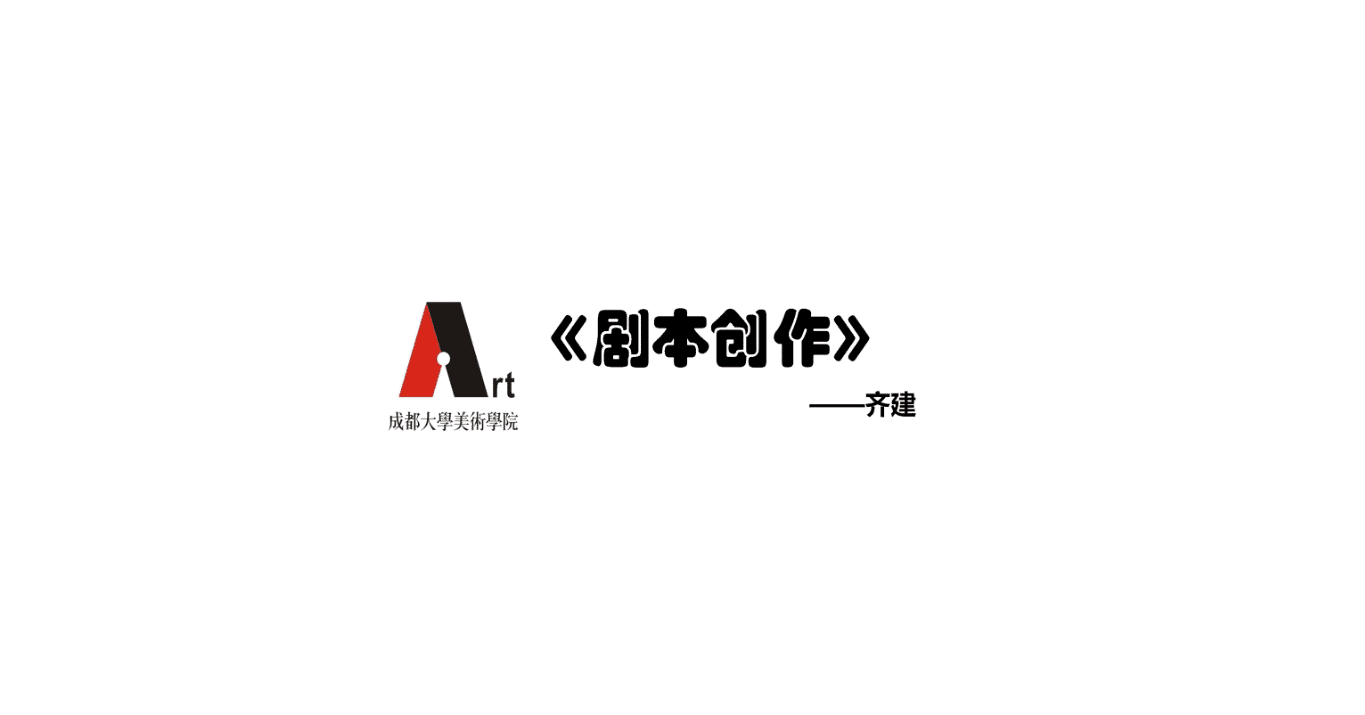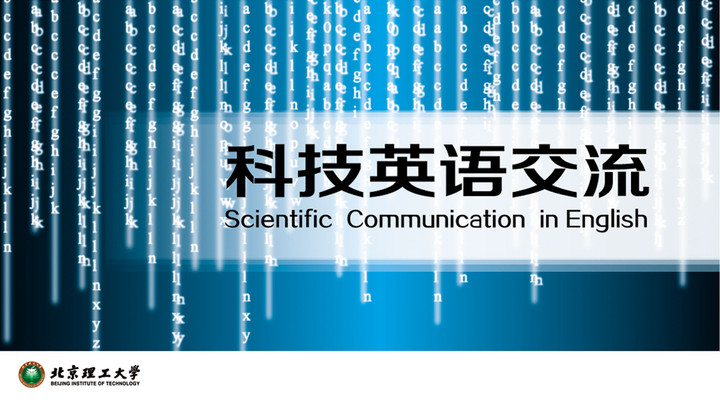
当前课程知识点:国际商务(英语授课) > 第一章 Globalization 全球化 > Business Focus 商务聚焦 > A glance at the global economy under COVID-19 pandemic 新冠疫情下的全球经济略览
A glance at the global economy under COVID-19 pandemic.pdf---点此下载文件
A glance at the global economy under COVID-19 pandemic
新冠疫情下的全球经济略览
在2019年末和2020年,新冠疫情给全球经济带来了重创。根据世界贸易组织、世界银行和联合国贸易与发展会议的数据统计,全球的货物、服务和对外投资都出现了大幅度下滑。中国经济也受到的影响。 但是在中国共产党的领导下,全国人民齐心奋战,GDP和货物贸易都有增长。
As we know that globalization refers to the shift toward a more integrated and interdependent world economy. However, the COVID-19 pandemic has given a heavy blow to an already weak global economy, which is expected to slide into its deepest recession since World War II.
Figure 1. World merchandise trade volume, 2015Q1 – 2019Q4
(Volume index 2015=100 and year-on-year percentage change)
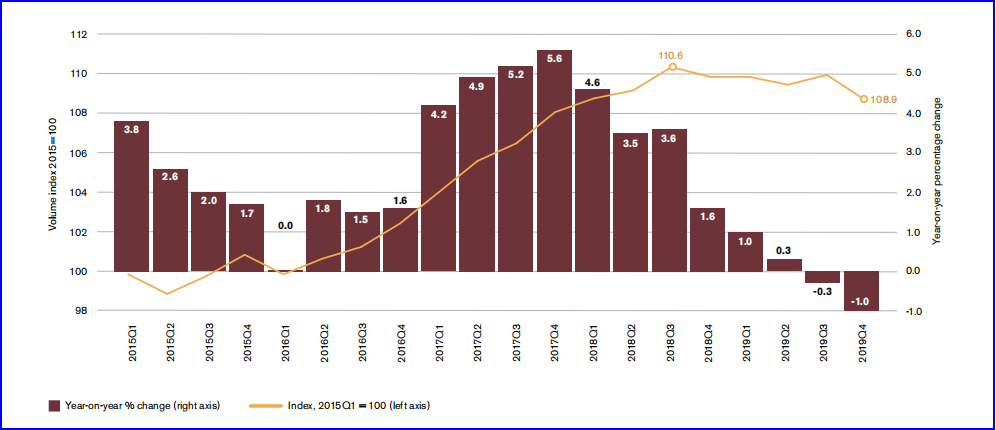
Source: World Trade Statistical Review 2020, p.19
Global merchandise trade volume peaked in the third quarter of 2018 before stalling for several months and turning down in the fourth quarter of 2019. Seasonally-adjusted merchandise trade volume was down by 1.0 per cent in the fourth quarter of 2019. The long-running trade dispute between the United States and China led to the raising of tariffs and contributed to trade policy uncertainty in 2019. Other factors contributing to economic uncertainty included the government shutdown in the United States in 2018-19, the United Kingdom’s departure from the European Union, and changes in monetary policy in major economies.
Figure 2. Merchandise exports of selected leading traders, April 2020
(Year-on-year percentage change)
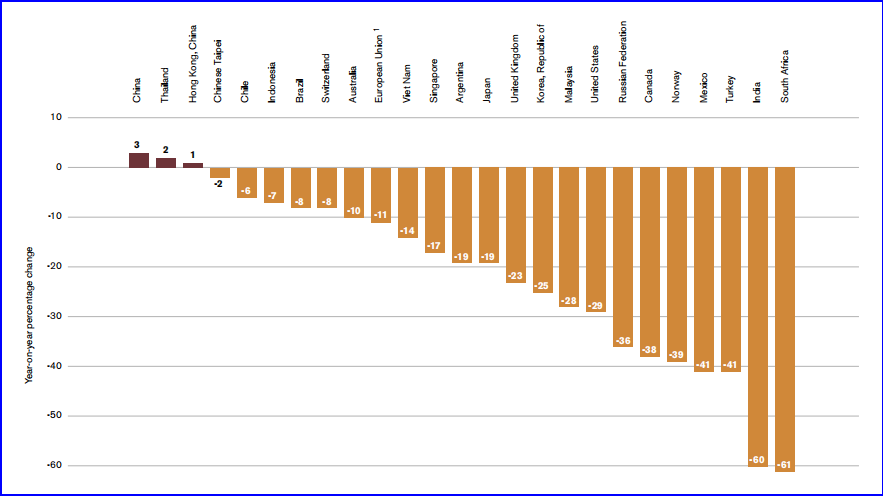
Source: World Trade Statistical Review 2020, p.30
Figure 2 shows that merchandise exports were down sharply in most economies in April 2020 compared with the previous year. Declines in merchandise exports of selected leading traders in April 2020 (year-on-year change) ranged from -2 per cent (Chinese Taipei) to -61 per cent (South Africa). Although certain Asian economies avoided declines in exports (in April 2020), their import growth remained negative. For example, imports of China and Thailand were down 14 per cent and 17 per cent, respectively, in April 2020.
Figure 3 illustrated that services are hit hard by the COVID-19 outbreak. Unlike goods, services cannot be produced, stored and sold at a later stage. Export revenues lost for canceled flights, restaurant meals or hotel bookings are lost permanently and cannot be recovered.
Figure 3. Services exports of selected leading traders, March 2020
(Monthly percentage change, year-on-year)

Source: World Trade Statistical Review 2020, p.31
International travel, for personal or business reasons, air transport, and cultural, sporting and recreational activities are all linked. They account for more than 40 per cent of world services exports.These services have been directly affected by the COVID-19 pandemic due to travel restrictions at home and in the host countries for these activities, making it impossible for people to move, consume or supply services. Growth remained positive in countries where exports are dominated by IT services.
From figure 4 we can see that the COVID-19 crisis caused a dramatic drop in foreign direct investment and will cause a further deterioration in 2021. Global FDI is projected to decrease by a further 5 to 10 per cent in 2021. The expected level of global FDI flows in 2021 would represent a 60 per cent decline since 2015, from $2 trillion to less than $900 billion. The outlook beyond 2021 is highly uncertain. A U-shaped trajectory, with a recovery of FDI to its pre-crisis trend line before 2022, is possible but only at the upper bound of the expectations.
Figure 4. Global FDI inflows, 2015–2019 and 2020–2022 forecast
(Trillions of dollars)
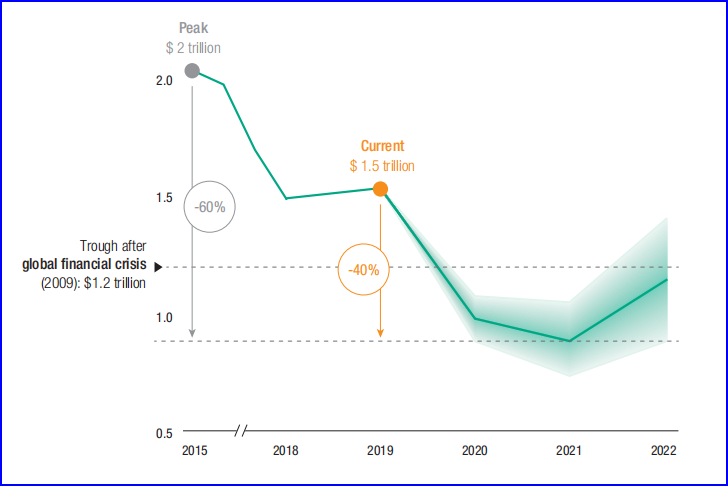
Source: World Investment Report 2020, p.2
China’s economy had greatly impacted by COVID-19 pandemic in 2020. However, under the leadership of Chinese Communist Party, all the people in the country made great endeavor and gained the hard-won achievements. According to the report by China Daily, in 2020, GDP reached 101.6 trillion yuan with GDP growth on a yearly basis 2.3% and foreign trade in goods reached 32.16 trillion yuan, up 1.9%.
Despite the impact of the COVID-19 pandemic and uncertainties in other parts of the world, China's foreign trade amounted to 5.44 trillion yuan ($834.49 billion) in the first two months of 2021, up 32.2 percent year-on-year. According to UNCTAD, during the COVID-19 pandemic China was able to capture markets share in many sectors including in some of the most negatively affected sectors (transport equipment and road vehicles).
Figure 5. China and East Asian economies gained market share during COVID
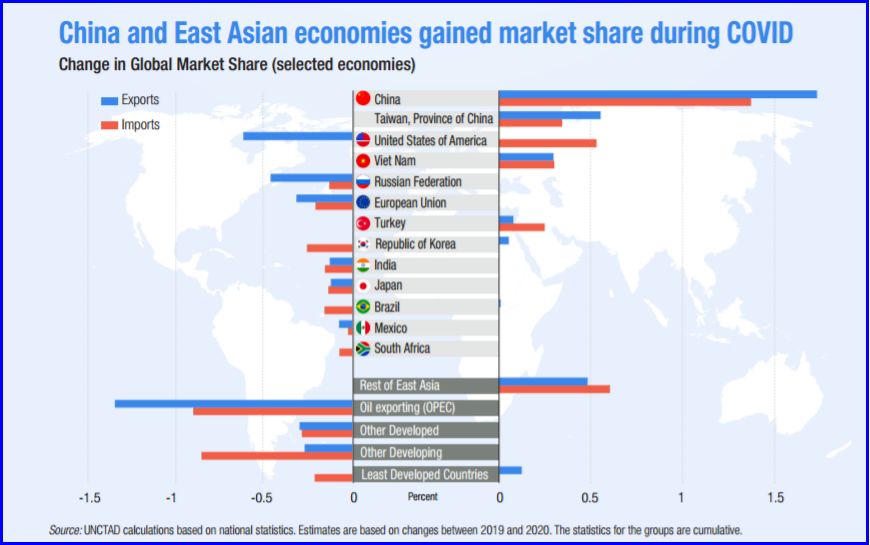
Source: Global Trade Update, January 2021, p.2
The World Bank expressed its outlook for the future of global economy under COVID-19 pandemic in the report of Supporting Countries in Unprecedented Times: Global Economic Prospects: Slow growth, policy challenges. The pandemic will likely leave lasting scars on the global economy by undermining consumer and investor confidence, human capital, and global value chains.
References:
1. World Trade Statistical Review 2020, the World Trade Organization
2. World Investment Report 2020, UNCTAD
3. Global Trade Update, January 2021, UNCTAD
4. http://www.chinadaily.com.cn/a/202103/03/WS603ebec0a31024ad0baac406.html accessed at March 3, 2021
5. https://www.chinadaily.com.cn/a/202103/07/WS60444777a31024ad0baad511.html Updated: 2021-03-07
-1.1 What is Globalization 什么是全球化?
--1.1 What is Globalization 什么是全球化?
-1.2 Glibalization of Markets 市场全球化
--1.2.2 Consumers and products 消费者和产品
-1.3 Globalization of Production 生产全球化
--1.3 Globalization of production 生产全球化
-1.4 Drivers of Globalization 全球化的驱动者
--1.4.1 Declining barriers 降低壁垒
--1.4.2 Technological change 技术变革
-1.5 The Changing Demographics of the Global Economy 全球经济变化中的统计数据
--1.5.1 Output and trade 生产总值和贸易
--1.5.3 Multinational enterprises 跨国企业
-1.6 The globalization debate 对全球化的争议
--1.6.2 labor policies and the environment 劳工政策和环境
--1.6.3 national sovereignty 国家主权
--1.6.4 the world’s poor 世界贫困人口
--Chapter 1 Globalization definitions
-第一章 Globalization 全球化--章末测试
-Chapter 1: Discussion 1.1 easy to compete?
-Chapter 1: Discussion 1.2 Technology and globalization
-Business Focus 商务聚焦
--A glance at the global economy under COVID-19 pandemic 新冠疫情下的全球经济略览
-2.1 Political system 政治体制
--2.1.1 What is a political system? 什么是政治体制?
--2.1.2 Collectivism and individualism 集体主义和个人主义
--2.1.3 Democracy and totalitarianism 民主与专制
-2.2 Economic System 经济体制
-2.3 Legal System 法律体制
--2.3.1 What is a legal system? 什么是法律体系
--2.3.3 Protection of intellectual property 保护知识产权
-2.4 The Determinants of Economic Development 经济发展的决定因素
--2.4.1 Differences in economic development 经济发展差异
--2.4.2 Political economy and economic progress 政治经济与经济发展
--Chapter 2 Differences in PE definitions
--Chapter 2 PPT Differences in PE
-章末测试--作业
-Chapter 2: Discussion 2.1 Why invest in China?
-Chapter 2: Discussion 2.2 The engine of economic growth
-3.1 What is Culture? 什么是文化?
--3.1.1 Why learn about culture? 为什么要学习文化
--3.1.2 Culture: Value 文化: 价值观
-3.2 Social Structure 社会结构
--3.2.1 Individuals and groups 个人和集体
--3.2.2 social stratification 社会分层
--3.2.3 social stratification:Li Zhao’s story 社会分层: 李钊的故事
-3.3 Language and Education 语言与教育
--3.3.2 Unspoken language 非口头语言
-3.4 Culture and the Workplace 文化与工作场所
--3.4.1 Culture expert: Geert Hofstede 文化专家:吉尔特·霍夫斯塔德
--3.4.2 Four dimensions: 1-2 四个维度:1-2
--3.4.3 Four dimensions: 3-4 四个维度:3-4
--Chapter 3 Culture Difference definitions
--Chapter 3 PPT Differences in Culture
-章末测试--作业
-Chapter 3: Dicussion 3.1 Culture and business
-Chapter 3: Discussion 3.2 An example of culture difference
-4.1 Mercantilism 重商主义
--4.1.1 An overview of trade theory 贸易理论综述
-4.2 Absolute Advantage 绝对优势
--4.2.1 Challenging the mercantilist philosophy 挑战重商主义
-4.3 Comparative Advantage 比较优势
--4.3.1 A positive sum gain 正和博弈
--4.3.3 Qualifications and assumptions 理论假定
-4.4 Heckscher-Ohlin Theory 赫克歇尔-俄林理论
--4.4.1 Factor endowments 要素禀赋
--4.4.2 the Leontief Paradox 里昂惕夫之谜
-4.5 The Product Life Cycle Theory 产品生命周期理论
--4.5.1 Product life cycle 产品生命周期
--4.5.3 Evaluating the product life cycle theory评价产品生命周期理论
-4.6 New Trade Theory 新贸易理论
--4.6.1 Economies of scale and first mover advantages规模经济和第一进入者优势
--4.6.2 Implications of new trade theory 新贸易理论应用
-4.7 National Competitive Advantage 国家竞争优势
--4.7.1 Porter's Diamond 波特的钻石模型
--4.7.2 Evaluating Porter's theory 评价波特的理论
--4.7.3 Implications for managers 对经理人的启示
--Chapter 4 Trade theory definitions
-章末测试--作业
-Chapter 4: Discussion 4.1 Why engage in international trade?
-Chapter 4: Discussion 4.2 Porter’s diamond
-Business focus 商务聚焦
--China-Zealand trade ties on the up thanks to FTA boost 自贸协定推动中国-新西兰经贸关系进一步发展
-5.1 Introduction 总体介绍
-5.2 Instrument of Trade Policy 1 贸易政策工具1
-5.3 Instrument of Trade Policy 2 贸易政策工具2
--5.3.2 voluntary export restraint 自愿出口限制
--5.3.3 antidumping duties 反倾销税
-5.4 Instrument of Trade Policy 3 贸易政策工具3
--5.4.1 local content requirements 国产化规定
--5.4.2 administrative policies 行政管理政策
-5.5 Political Arguments for Government Intervention 政府干预的政治理由
--5.5.1 protecting jobs and industries 保护就业和产业
--5.5.2 national security 国家安全
--5.5.4 protecting consumers 保护消费者
--5.5.5 furthering foreign policy objectives 推动对外政策目标
--5.5.6 protecting human rights 保护人权
-5.6 Economic Arguments for Government Intervention 政府干预的经济理由
--5.6.1 infant industry argument 幼稚产业论
--5.6.2 strategic trade policy 战略性贸易政策
-5.7 Managerial Implication 管理者启示
--5.7 Managerial Implication 管理者启示
--Chapter 5 Political Economy in IT definitions
--Chapter 5 PPT Political Economy of IT
-章末测试--作业
-Chaper 5: Discussion 5.1 Government intervention
-Chapter 5: Discussion 5.2 Trade barriers
-Business focus 商务聚焦
--China imposes anti-dumping duties on imports of wine from Australia 中国对从澳大利亚进口的葡萄酒征收反倾销税
-6.1 Introduction 引言
-6.2 FDI in the World Economy 世界经济中的外国直接投资
--6.2.1 Trends in FDI 外国直接投资的趋势
--6.2.2 The Direction of FDI 外国直接投资的流向
-6.3 Theories of Foreign Direct Investment 外国直接投资理论
--The Pattern of FDI 外国直接投资的模式
-6.4 Benefits and Costs of FDI 外国直接投资所带来的收益和成本
-- Host-Country Benefits 东道国收益
-6.5 Government Policy Instruments and FDI 政府政策工具与外国直接投资
-6.6 Implications for Managers 对企业经营者的启示
-- The Theory and Government Policy 投资理论和政府政策
-章末测试--作业
-Chapter 6: Dicussion 6.1 FDI for host
-Chapter 6: Dicussion 6.2 FDI for home
-7.1 Introduction介绍
-7.2 Value Creation价值创造
-7.3 Strategy and Strategic Positioning战略和战略定位
--7.3 Strategy and Strategic Positioning 战略与定位
-7.4 Operations运作
-7.5 Organization and Strategic Fit组织和战略匹配
--7.5 Organization and Strategic Fit 组织与战略匹配
-7.6 Pressures and International Strategy 压力与国际战略
--7.6 Pressures and International Strategy 压力与国际化战略
--Chapter 7 Business Strategy definitions
--Chapter 7 PPT Business Strategy
-章末测试--作业
-Chapter 7: Discussion 7.1 Primary strategies
-Chapter 7: Discussion 7.2 Four strategies
-8.1 The Functions of Foreign Exchange Market 外汇市场的功能
--8.1 The Functions of the Foreign Exchange Market 外汇市场的功能
-8.2 Prices and exchange rates 价格和汇率
--8.2 Price and Exchange Rates 价格和汇率
-8.3 Exchange rate determination 汇率决定因素
--8.3 Exchange rate determination 汇率决定因素
-8.4 Exchange rate forecasting 汇率预测
--8.4 Exchange rate forecasting 汇率预测
--Chapter 8 FX Market definitions
--Chapter 8 PPT Foreign Exchange Market
-章末测试--作业
-Chapter 8: Discussion 8.1 Hedge and forward
-Chapter 8: Discussion 8.2 Inflation
-9.1 Introduction of accounting? 会计简介
--9.1.1 What is accounting? 什么是会计
--9.1.3 The Statement of Retained Earnings 留存收益表
--9.1.5 Statement of Cash Flows 现金流量表
--9.1.6 The relationships among statements 报表间关系
--9.1.7 Functions of financial statements 财务报表的作用
-9.2 Accounting Standards会计准则
--9.2.1 National Standards国家准则
--9.2.2 International Standards国际准则
-9.3 Accounting systems and multinational enterprises 会计体系与跨国企业
--9.3.1 Accounting and control systems会计和控制体系
--9.3.2 Subsidiary performance evaluation子公司业绩评价
-9.4 Financial Management 财务管理
--9.4.1 Investment decisions 投资决策
--9.4.2 Financing decisions 筹资决策
--Chapter 9 Accounting & Finance definitions
-章末测试--作业
-The blockage of the Suez Canal has disrupted global trade 苏伊士运河堵塞影响全球贸易
-Hainan FTP: greater opening-up, greater achievement 海南自贸港: 更大的开放,更多的成就
-China's Q1 foreign trade hits highs 中国一季度外贸创历史新高
-Global pharma giants step up alliances in Chinese market 全球制药巨头在中国市场加强联盟
-Digital RMB pilot programs expand 数字人民币试点再扩容
-A shares continue to attract foreign interest A股继续吸引外资关注
-Boao Forum for Asia Annual Conference 2021 博鳌亚洲论坛2021年年会
-China’s backlash against the western boycott of Xinjiang Cotton 中国对西方抵制新疆棉花的回击

